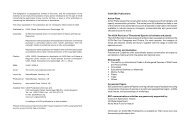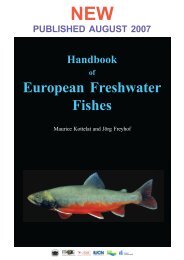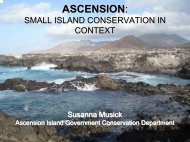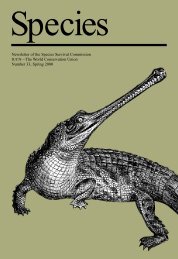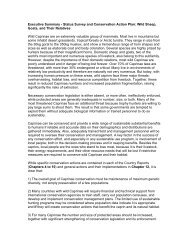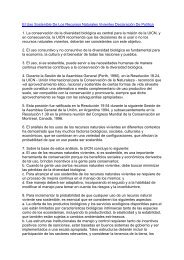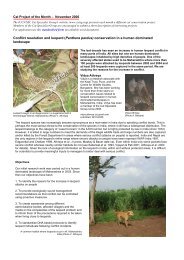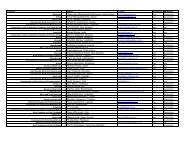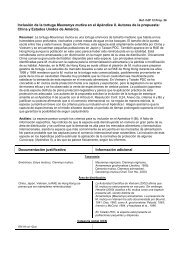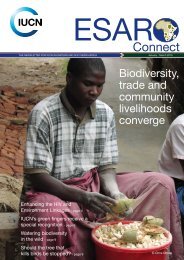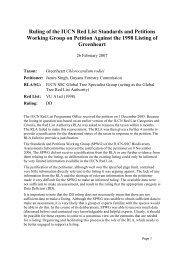Planning education to care for the earth - IUCN Knowledge Network
Planning education to care for the earth - IUCN Knowledge Network
Planning education to care for the earth - IUCN Knowledge Network
Create successful ePaper yourself
Turn your PDF publications into a flip-book with our unique Google optimized e-Paper software.
Effects of <strong>education</strong> on seabird conservationDiscussionThe <strong>education</strong> programme promoted thoughtful, in<strong>for</strong>med, positivebehaviour (legal hunting, bird study) ra<strong>the</strong>r than focusing on s<strong>to</strong>ppingnegative behaviour (poaching). The programme did not try <strong>to</strong> introduceactivities that would be strangely new <strong>to</strong> <strong>the</strong> local culture (raising chickens,<strong>for</strong> example), recognizing that <strong>the</strong>re were good reasons why previousattempts had not taken hold. Ra<strong>the</strong>r than attempting <strong>to</strong> convince people thatit was wrong <strong>to</strong> kill birds, <strong>the</strong> programme acknowledged <strong>the</strong> basic culturalnorm: it is acceptable <strong>to</strong> harvest birds <strong>for</strong> an occasional meal, especially if<strong>the</strong>y are needed as food. (The need had in fact begun <strong>to</strong> decline with <strong>the</strong>introduction of freezers <strong>for</strong> food s<strong>to</strong>rage in <strong>the</strong> late 1960s, but it <strong>to</strong>ok <strong>the</strong><strong>education</strong>al programme <strong>to</strong> make evident this change.)O<strong>the</strong>r fac<strong>to</strong>rs helped <strong>to</strong> pass on <strong>the</strong> conservation message. Communityleaders influenced <strong>the</strong>ir peers, <strong>the</strong> children, and residents of o<strong>the</strong>rcommunities. The relative isolation of small communities meant that <strong>the</strong>rewas little competition <strong>for</strong> <strong>the</strong> good things a conservation programme offered.Children, <strong>for</strong> example, were anxious <strong>to</strong> take part in <strong>the</strong> St Mary’s Islandprogramme. People responded more <strong>to</strong> <strong>the</strong> norms of <strong>the</strong> group <strong>to</strong> which <strong>the</strong>ybelonged than <strong>to</strong> regulations, and spreading <strong>the</strong> message among peer groupswas more effective than posting signs or addressing large audiences.Although harvesting birds was <strong>the</strong> cus<strong>to</strong>m, <strong>the</strong> culture never<strong>the</strong>lesssupported <strong>the</strong> conservation principle that seabird populations be res<strong>to</strong>red <strong>to</strong>sustainable levels. Working with, ra<strong>the</strong>r than against, socio-cultural fac<strong>to</strong>rswas important so that <strong>the</strong> goals of both biological and cultural conservationcould be attained.Although <strong>the</strong> increase in en<strong>for</strong>cement contributed <strong>to</strong> <strong>the</strong> control of illegalharvest, as sociologists would point out, <strong>the</strong> introduction of extrinsicmotivation without regard <strong>to</strong> o<strong>the</strong>r fac<strong>to</strong>rs would have predictably failed <strong>to</strong>produce durable, long-term behaviour change (Katzev and Pardini 1987-1988). Fur<strong>the</strong>rmore, heavy-handed en<strong>for</strong>cement alone likely would havetriggered reactance, which induces behaviour in <strong>the</strong> opposite direction(Brehm 1966, Brehm and Brehm 1981). Evidence of this behaviour during<strong>the</strong> years immediately be<strong>for</strong>e <strong>the</strong> project began <strong>to</strong>ok <strong>the</strong> <strong>for</strong>m of occasionalnight raids <strong>to</strong> <strong>the</strong> seabird colonies <strong>for</strong> eggs (Blanchard and Monroe 1990).Sociologists agree that durable behaviour change requires <strong>the</strong> use oftechniques such as social commitment, intrinsic behaviour, and supportingattitudes (Heberlein 1981, DeYoung 1985-1986, DeYoung and Kaplan 1985-1986, Katvez and Johnson 1987).The conceptual framework <strong>for</strong> an <strong>education</strong> programme that targets aconservation problem in rural, less developed regions consists of four basicphases: research, planning, implementation and evaluation. This progressionallows <strong>for</strong> feedback, constructive decisions and modifications <strong>to</strong> future work.Research provides in<strong>for</strong>mation on <strong>the</strong> socio-cultural context that is necessary<strong>to</strong> develop <strong>education</strong> strategies. It assesses root causes of <strong>the</strong> problem,identifies audiences and opinion leaders, and leads <strong>to</strong> <strong>the</strong> development ofshared programme goals. In <strong>the</strong> planning phase, <strong>education</strong>al goals are45



